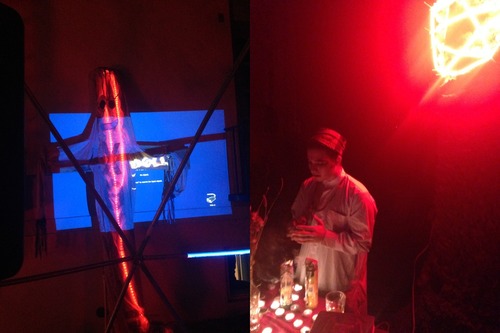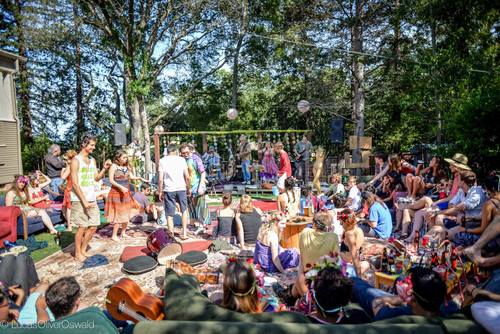
On Friday night, I finally found the comfortable space I needed to explore my identity as a witch.
As it turns out, I have always been a witch. But I had trouble admitting this even to myself, until 576 opened their hearts and their courtyard to a gathering of witches. Within minutes of arriving, I was sipping a mystery potion and bobbing my head to the slow, thick beat of a song with lyrics like incantations. The Lacoste polo I had been wearing all day disappeared beneath a frilly dress patterned with black vines, and my hair was held back by a black tie dotted with white skulls. My fellow witches and I danced strange and terrible waltzes as together we celebrated the liberation of a magic buried deep inside of us.

To call it a party sounds somehow cheap - Witch Party was more of an experiment, and a beautiful one at that. Those of us who chose to step inside the geodesic dome and dance before the wicked, postmodern altar were all entering into an implicit blood oath that we would be pushing the bounds of normalcy. I made my best scary faces and competed in make-believe duels. I played with the diaphanous veils dangling from the dome and danced geometrically with a witch in a geometric bodysuit. I was taken to a room labeled “Seancé” and made to kneel before a demonic icon of the Queen herself while she repeatedly commanded, “bow down bitches.” I cowered on the floor for several minutes before returning to the dome.
I like to say that 576 is my “home away from home away from home” - my first home being with my family in Danville, and the second being Theta Delt at Stanford. I enjoy spending time at 576 because it is a space in which I feel comfortable doing and saying things that I can’t do at either of my other homes. Though I come from a loving, supportive family and generally believe Theta Delt to be one of the most welcoming communities on campus, there are certain aspects of myself that I feel most comfortable expressing within the safe and supportive walls of 576. My witchiness is one such aspect; my queerness is a distinctly parallel second. My family and my fraternity both accept me for everything that I am - but sometimes I feel the need be to surrounded by people who can relate to me on other unique levels. 576 is a special place, one where you might discover yourself to be weirder than you ever thought possible - and receive nothing but love and admiration for it.

The differences between Greek and co-op spaces felt especially evident the next day, when Theta Delt’s early celebration of Cinco de Mayo coincided with both Synergy’s Beltane Festival and the madness that we know as SAE Linner. All three spring rituals ran all day long, within a radius small enough to allow revelers like myself to orbit freely between the various celestial celebrations (though I must admit I could not bring myself to Linner).
While the majority of people stuck to their own scene, those of us who took advantage of the multiple parties got to experience a fascinating dialectical movement back and forth between the drunken raging of the frats and the peaceful paganism of Beltane. I turned up in the Theta Delt backyard just after noon and had a margarita made in my mouth within a minute; four hours later, I was at Synergy carefully weaving flowers into a Dionysian crown. When I returned to Theta Delt with a green stripe painted down my face, I danced manically across the picnic tables to the latest trap anthems and Nelly’s “Pimp Juice”; during my second go at Beltane, I bounced on a broken trampoline as long-haired hippies from San Francisco jammed live on stage. One place was loud, slippery, and charged; the other felt soft, grassy, and meditative. Though they shared the same spring sun, it was hard to believe these two worlds could exist on the same campus, let alone separated by just one sloping hill.
But physical space is not the only thing that comes between Theta Delt and Synergy. These two properties house two communities with divergent and sometimes opposing values. We might share a love for socializing and smoking pot, but our cultures differ wildly in the way we approach gender, tradition, and cooperation, among many other things.
The difference is also one of external perception: to live in a co-op is to be seen as assuming a distinct identity from one who rushes and pledges a fraternity. It is possible to transgress these boundaries, but it is not common, in part because they are often actively re-enforced by the people within each community. A friend of mine in a co-op was mocked for hanging out with her friends at TDX when she “should have been at Beltane.” A resident of one of the other Lomita fraternities openly sneered at me when I returned from Synergy looking like tUnE-yArDs on a bad hair day. Hell, even I openly judged people when I heard they spent more time at Linner than would be minimally necessary to Instagram the absurdity. In all such judgments, we re-enforce the myth that the things that divide Stanford students are more essential than the things that we share, and that’s one myth I refuse to believe in.

On Saturday, we proved that we have a lot in common - we all enjoy gathering in the sun, blasting music, eating good food, and consuming mind-altering substances with friends. Why do we insist on limiting our own fun by marking certain people, spaces, and activities as outside the limits of what we’re cool with? The party at TDX would have only improved with the addition of face paint and flowers, and Beltane should have definitely had a frat-style slip-n-slide. I would’ve loved to see live music at Theta Delt, and both fraternities could take a lesson from Synergy when it comes to hosting events that feel comfortable for wider and weirder swatches of the student population. There is so much our communities could learn from each other, if only we were more willing to share our spaces and listen.
(This is to say nothing of the many students who don’t live in co-ops or Greek houses, or of those equally valuable human beings who - gasp - don’t attend Stanford at all. I enjoyed being surrounded by many of the latter during my brief foray into Blackfest, another of Saturday’s spring celebrations. Once I got over the initial disorientation of being immersed in an unfamiliar culture, I was excited by the faces and styles typically underrepresented on campus. In my frat-tank and swimsuit, I stood out like a sore white boy, but I shared in singing and dancing to the Beyoncé covers all the same.)
After dinner at Theta Delt, cooked by our longtime chef Luis and shared with anyone who came through our kitchen, I walked with a friend from EBF to the Nitery to catch Maya Kazin’s senior thesis, “Elephant.” I still had paint on my face, flowers in my hair, and alcohol in my veins, but I was nonetheless very moved by the play. With a gorgeous realism, Maia represented the intense frustrations that arise when two very different communities attempt to communicate.
I left the show thinking about Theta Delt and the things we could do to start fruitful conversations with communities on campus with whom we do not usually interact. These were just the seeds of ideas, but I found water for them when I returned once more to Synergy and found a rich mélange of people continuing to ride the vibes of Beltane on toward the sunrise. As I chatted, danced, and shared, I remained continuously surrounded by a mix of frat boys, co-op girls, everything in between, and everything that defies labels entirely. I made new friends and met old alums. And when it came time to inaugurate Synergy’s new House Manager, we were all swept up in the frenzy of bodies streaming toward the side of the property, where together we watched a clandestine fire ceremony and shouted congratulations. As the flames fell, the ceremony dissolved into a drum circle around the fire, where people improvised with each other, smiled at one another, learned each other’s names. Nobody felt the need to ask others where they came from or what they were doing at Beltane. Our motivations were clear: we had all come to share warmth, music, and time with other humans. And a couple of dogs. And at least a few witches.
photo credits to Imani Howard, Michael Rector, Lucas Oswald, Alex Ritchie
